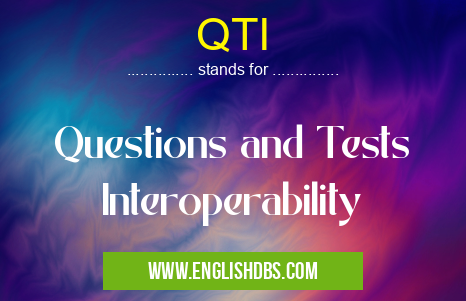What does QTI mean in UNCLASSIFIED
QTI stands for Questions and Tests Interoperability. It is a set of standards and specifications that enable the development, delivery, and assessment of digital educational content, such as questions, tests, and surveys. QTI aims to promote interoperability among different educational platforms, allowing users to easily share and reuse digital content.

QTI meaning in Unclassified in Miscellaneous
QTI mostly used in an acronym Unclassified in Category Miscellaneous that means Questions and Tests Interoperability
Shorthand: QTI,
Full Form: Questions and Tests Interoperability
For more information of "Questions and Tests Interoperability", see the section below.
Benefits of QTI
- Increased interoperability: QTI ensures that digital educational content can be exchanged and used across different platforms and systems.
- Improved quality: QTI defines a common set of quality criteria, ensuring that digital content meets certain standards.
- Reduced development costs: By providing a standardized framework, QTI reduces the time and effort required to develop digital educational content.
- Enhanced accessibility: QTI supports various accessibility features, making digital content more accessible to students with disabilities.
Key Features of QTI
- XML-based: QTI content is stored in XML format, enabling easy parsing and interoperability.
- Item metadata: QTI provides a rich set of metadata, including item difficulty, response types, and scoring rubrics.
- Item response processing: QTI defines item response processing rules, allowing automated scoring of responses.
- Adaptive testing: QTI supports adaptive testing, where the difficulty of items is adjusted based on student performance.
Use Cases of QTI
QTI is widely used in various educational settings, including:
- Online testing and assessment: QTI enables the creation and delivery of online tests and assessments.
- Banked item pools: QTI can be used to create and manage item pools that can be shared among different assessments.
- Educational research: QTI supports the analysis and evaluation of digital educational content.
- Adaptive learning systems: QTI can be incorporated into adaptive learning systems to tailor content to individual student needs.
Essential Questions and Answers on Questions and Tests Interoperability in "MISCELLANEOUS»UNFILED"
What is QTI?
QTI stands for Questions and Tests Interoperability. It is a set of XML-based standards that allow for the exchange of assessment items and tests between different systems. QTI enables the creation, delivery, and scoring of assessments in a consistent and interoperable manner.
What are the benefits of using QTI?
QTI offers several benefits, including:
- Improved interoperability: QTI allows assessment items and tests to be shared and used across different systems, regardless of the vendor or platform.
- Increased efficiency: QTI streamlines the assessment creation and delivery process by automating many tasks, such as item banking and test assembly.
- Enhanced accessibility: QTI supports the creation of accessible assessments that can be used by students with disabilities.
- Greater flexibility: QTI enables the creation of assessments that can be tailored to specific needs and requirements.
What are the different types of QTI standards? A: QTI includes several different standards, each covering a specific aspect of assessment interoperability: QTI Assessment Structure: Defines the structure and metadata of assessments. QTI Item Metadat
QTI includes several different standards, each covering a specific aspect of assessment interoperability:
- QTI Assessment Structure: Defines the structure and metadata of assessments.
- QTI Item Metadata: Specifies the metadata associated with assessment items.
- QTI Item Presentation: Describes the presentation of assessment items to students.
- QTI Interaction: Defines the interactions that students can use to respond to assessment items.
- QTI Outcome Processing: Specifies the rules for calculating the scores and results of assessments.
How is QTI used in practice?
QTI is used in a variety of educational and assessment contexts, including:
- Learning management systems (LMSs): LMSs use QTI to import and export assessments.
- Assessment authoring tools: These tools allow educators to create QTI-compliant assessments.
- Assessment delivery systems: These systems deliver QTI-based assessments to students.
- Item banks: Item banks store QTI-compliant assessment items that can be reused in multiple assessments.
Final Words: QTI plays a vital role in the interoperability and quality of digital educational content. By providing a standardized framework, QTI enables the sharing, reuse, and assessment of digital content across different platforms and systems. This enhances the efficiency, accessibility, and effectiveness of online learning and assessment.
